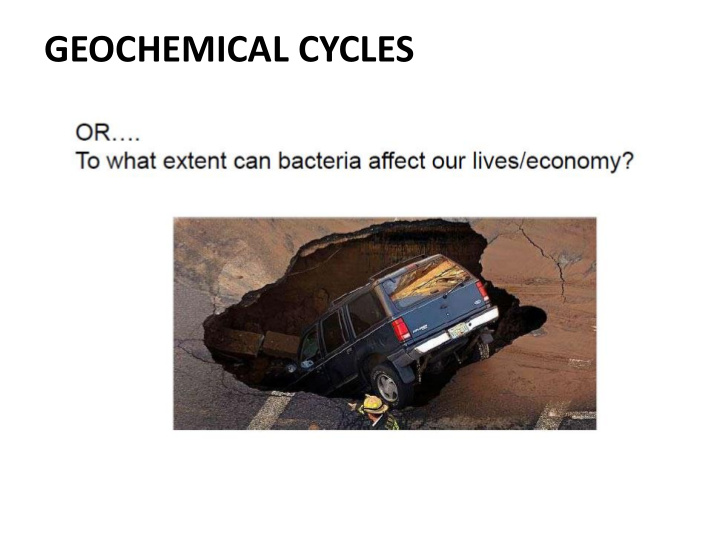



GEOCHEMICAL CYCLES
Carbon Reservoir Carbon (gigatons) Percent of total carbon on Earth Oceans 38 x 10 3 0.05% (95% is inorganic) Rocks & sediment 75 x 10 6 99.5% (80% is inorganic) Terrestrial biosphere 2 x 10 3 0.003% Aquatic biosphere 1-2 0.000002% Fossil fuels 4.2 x 10 3 0.006% Methane hydrates 10 4 0.014%
Carbon Involving: heterotrophic and autotrophic organisms
Carbon
Carbon Syntrophy is a metabolic process in which two or more organisms cooperate in the degradation of some compound. This is most evident in methanogenesis .
Nitrogen • Principle form = N 2 • Nitrification – Limited use to micro- – Oxidation of ammonia organisms – Two-step process (ammonia – Nitrogen fixing bacteria oxidation + nitrite oxidation) – Sensitive process • Ammonia • Denitrification – Product of nitrogen fixation – Ammonification – Loss of nitrogen from biosphere – Nitrate N 2 • Anammox – Anaerobic oxidation of ammonia – Nitrite as intermediate
Nitrogen
• Nitrogen transformation – Ammonium is readily uptaken and biochemically processed – Nitrate needs to be reduced – Nitrate- and nitrite reductases – Some organisms cannot utilise nitrate/nitrite
Nitrogen • Nitrogen fixation – N 2 + (at least) 6 ATP 2 NH 3 – Some cyanobacteria, Azotobacter, Rhyzobium, Bradyrhizobium – Nitrogenase enzyme – Nitrogenase is irreversibly inhibited by O 2 – Specialised structures are utilised to protect nitrogenase -- heterocysts – Requires much energy, exudates from roots facilitate energy supply.
Nitrogen • Ammonification – Organic-N NH 4 + CO 2 + energy – Under anaerobic conditions, used to be called “ putrefication ” – wonder why...?
Nitrogen • Nitrification – NH 3 + 1.5 O 2 + CO 2 NO 2 + H 2 O + H + +energy – Nitrosomonas (and a few others) – Ammonia monooxygenase – NO 2 + 0.5O 2 + CO 2 energy + NO 3 – Nitrobacter + Nitrospira – May also be done by Crenarchaeota (ammonia oxidising archaea)
Nitrogen • Anammox – NH 4 + NO 2 N 2 + 2H 2 O (hydrazine as intermediate) – Planctomycetee ( Brocadia , Kuenenia , Jettenia , Salindua ) – Use nitrite as an oxidant (Kuenen & Jetten 2001, ASM news 57:456) – Recently discovered, but may be very important process (65% of N2 production in Baltic sea) – Organisms’ doubling time = 2 weeks!
Nitrogen • Denitrification – Alternate form of respiration – NO 3 NO 2 NO N 2 O N 2 – Many bacteria
Sulphur
Sulphur • Sulphide/sulphur oxidation – Sulphur chemolithotrophs – Thiobacillus, Beggiotoa, many other aerobes – Purple and green phototrophic bacteria (anaerobes)
Sulphur • Sulphide/sulphur oxidation – Beggiotoa: H 2 S + ½ O 2 S + H 2 O + ATP sulphur is stored, then when sulphide depletes: 1.5 O 2 + S + H 2 O H 2 SO 4 + ATP – Thiobacillus: 2Na 2 S 2 O 3 + O 2 2S + Na 2 SO 4 + ATP - + 2CO3 - 5SO 4 2- + 2CO 2 + 3N 2 + ATP or, 5S + 6NO 3 – Photosynthetic sulphur bacteria: 2CO 2 + 2H 2 O + H 2 S + light 2(CH 2 O) + H 2 SO 4 or, CO 2 + H 2 S 2(CH 2 O) + S
Sulphur • Sulphur reduction – Alternate respiration bacteria – Desulfovibrio, Desulfomaculum 2- + 2(CH 2 O) 2CO 2 + 2H 2 O + S 2- + ATP – SO 4 2- + 4H 2 4H 2 O + S 2- + ATP – SO 4 - + CH 3 COO - + H + HS - + 2CO 2 + H 2 O – S 2 O 3 – They make mud “stink”
Sulphur • Dimethyl sulphide – Main gaseous product of sulphur cycle – Marine algae, cyanobacteria, some plants – Chemical defense – “Tidal” smell contributor – Dimethyl sulphide + light sulphonic acid – Sulphonic acid H 2 SO 4 + CO 2 + energy
Recommend
More recommend